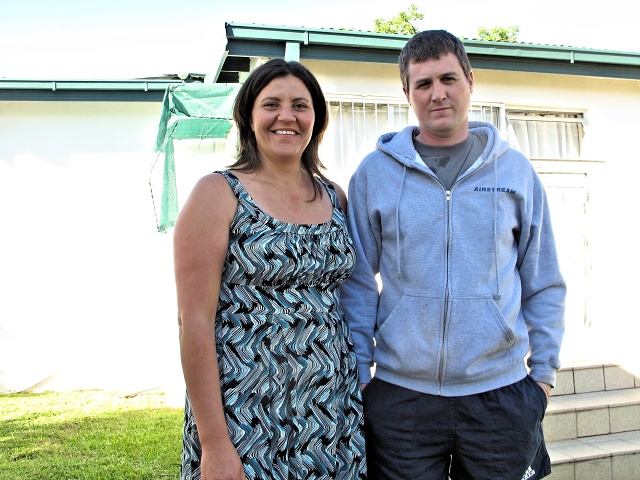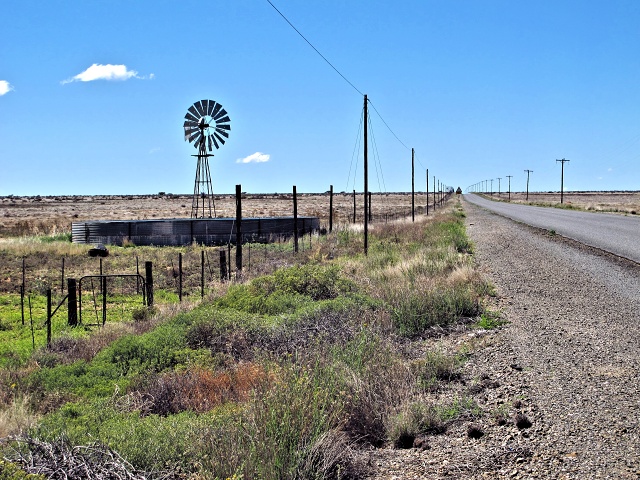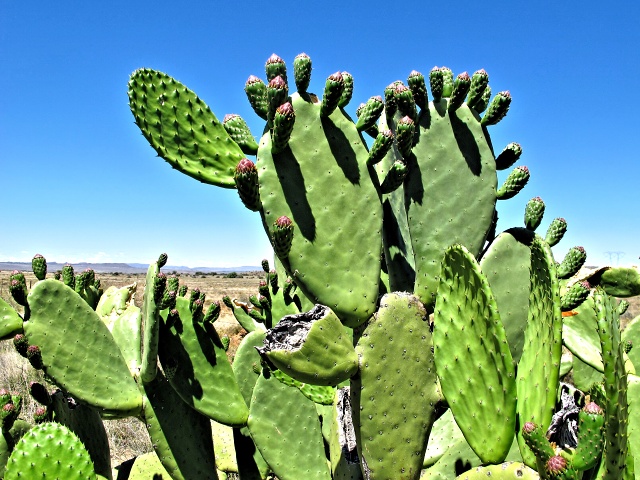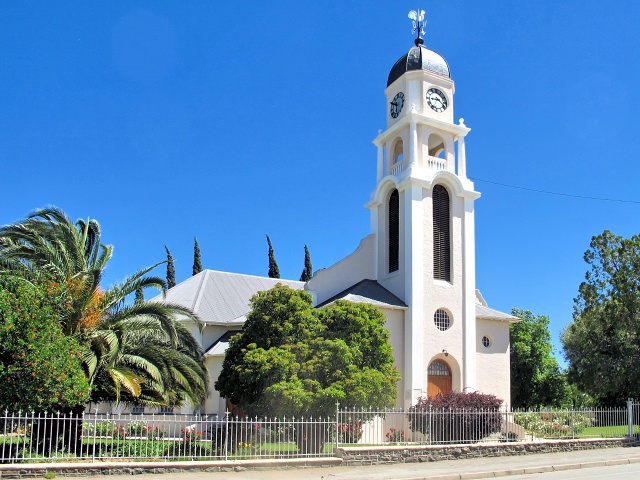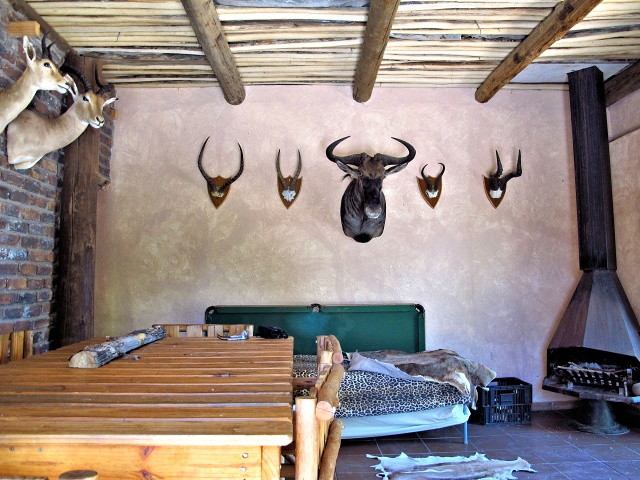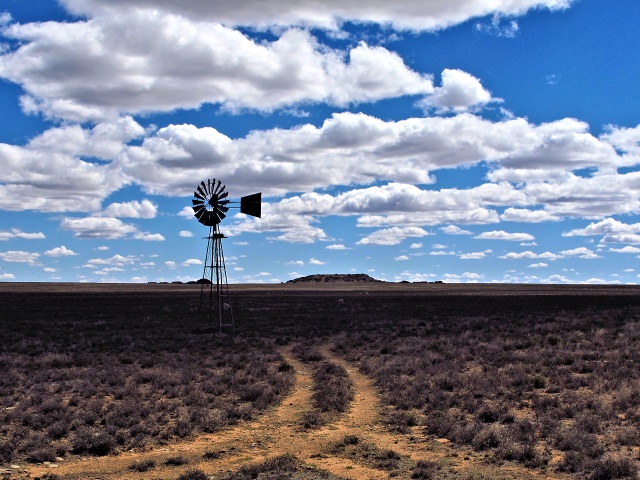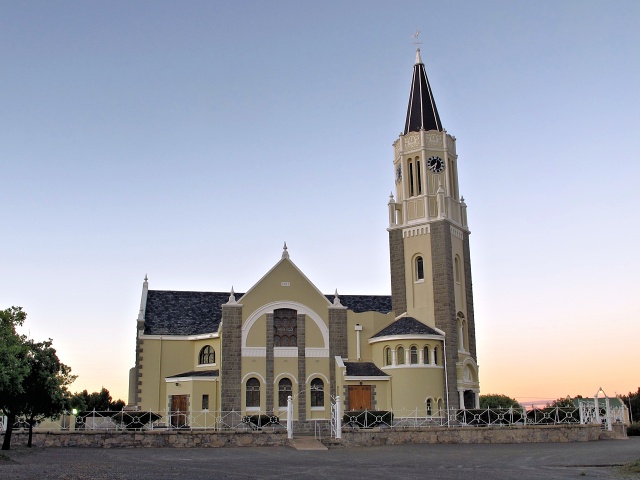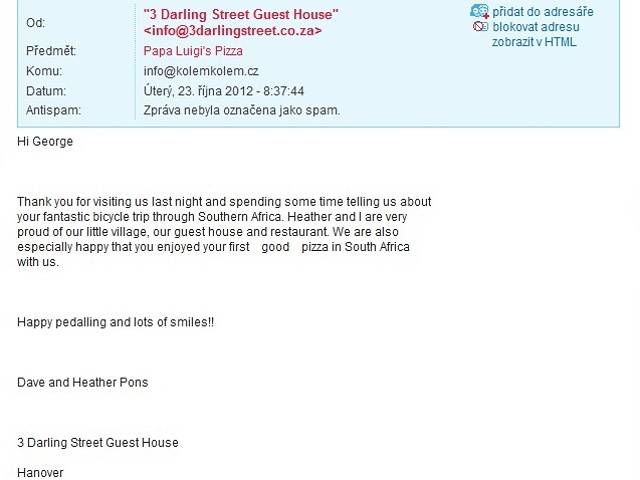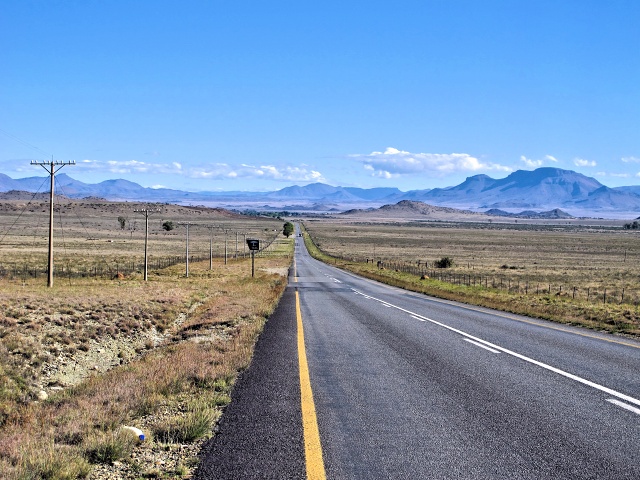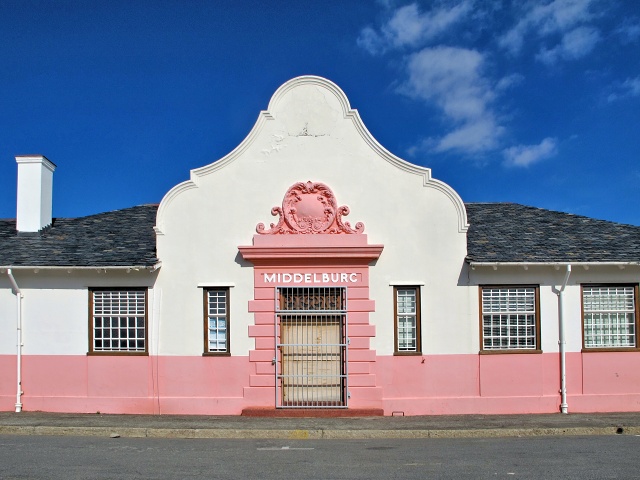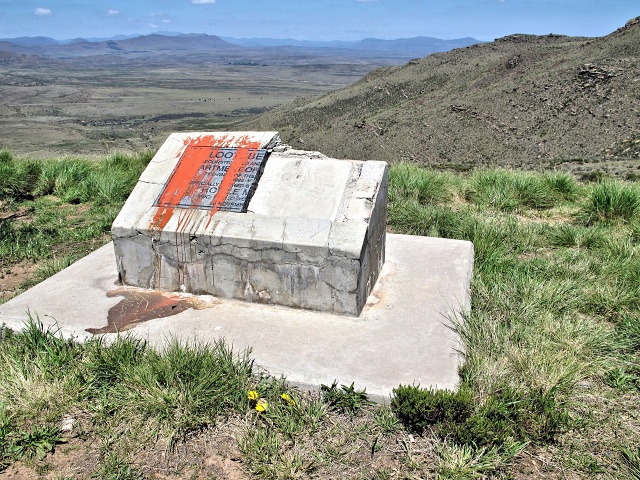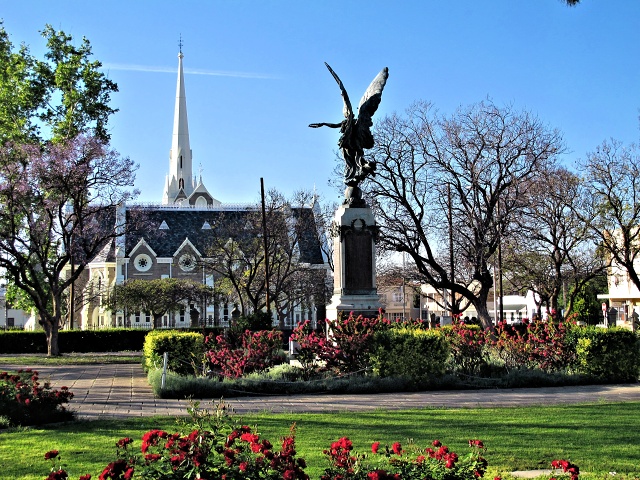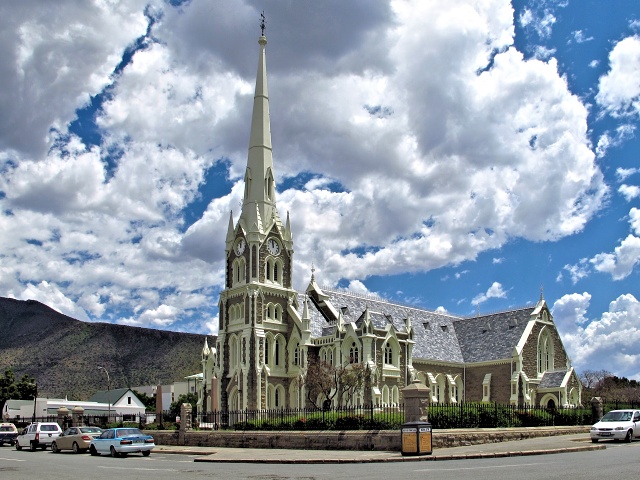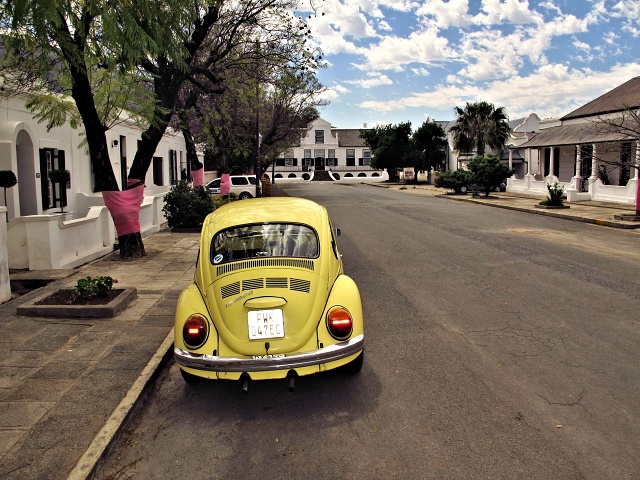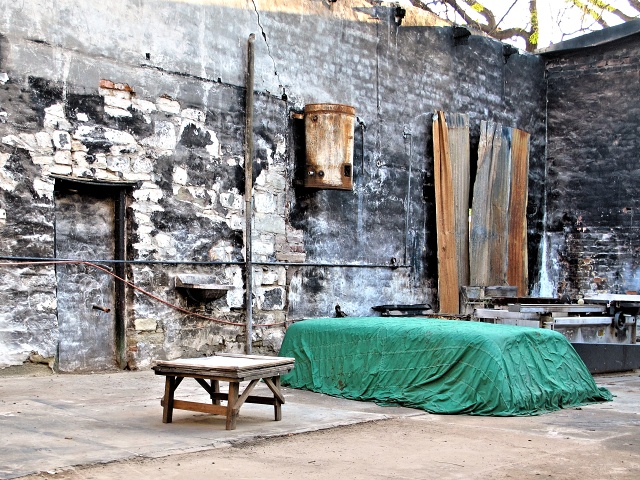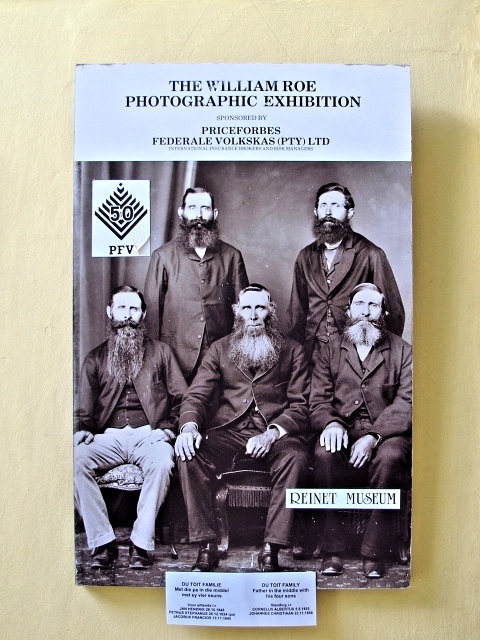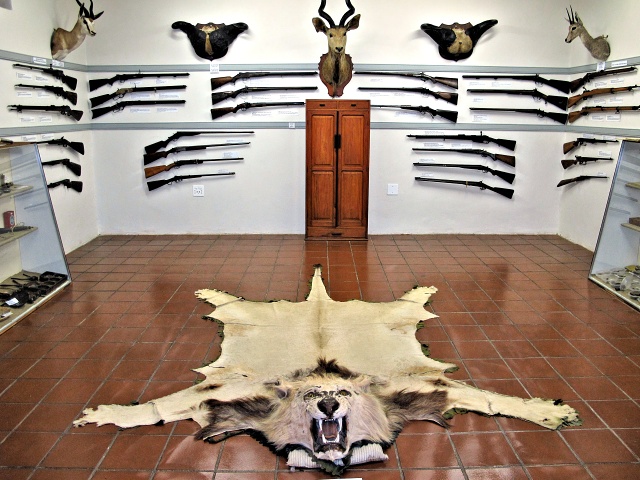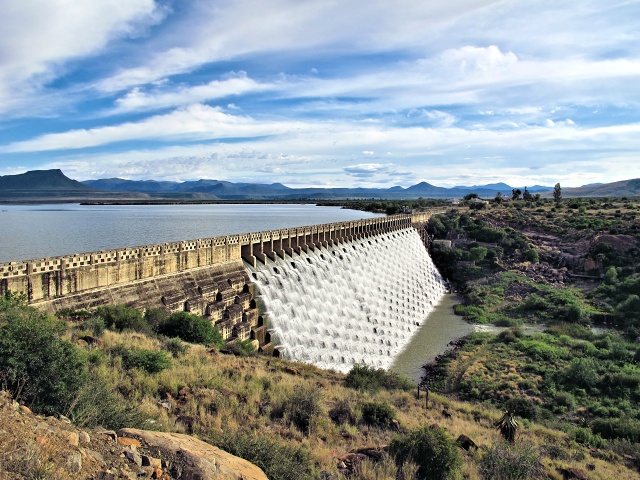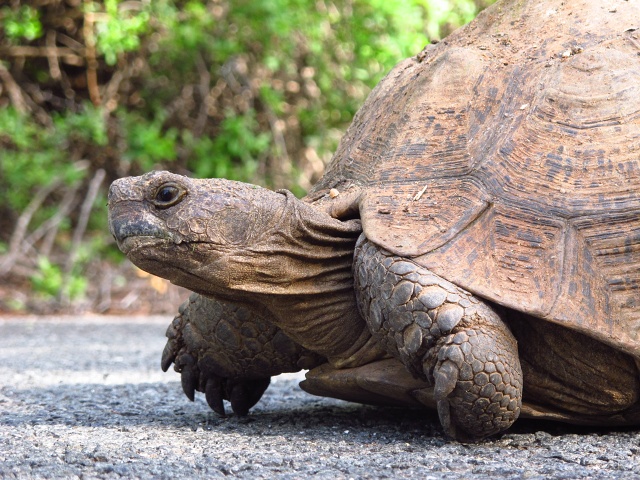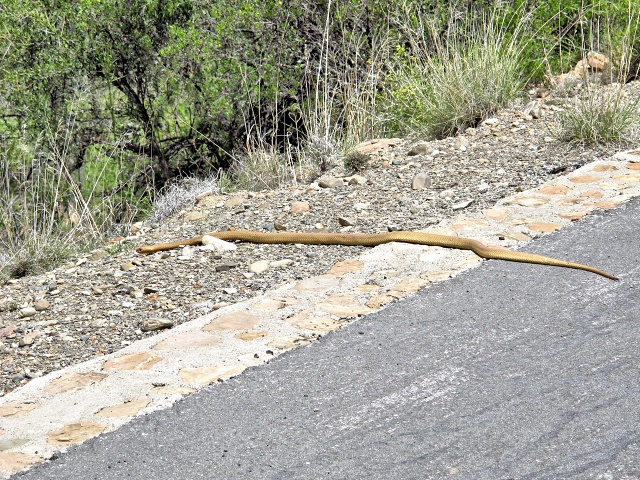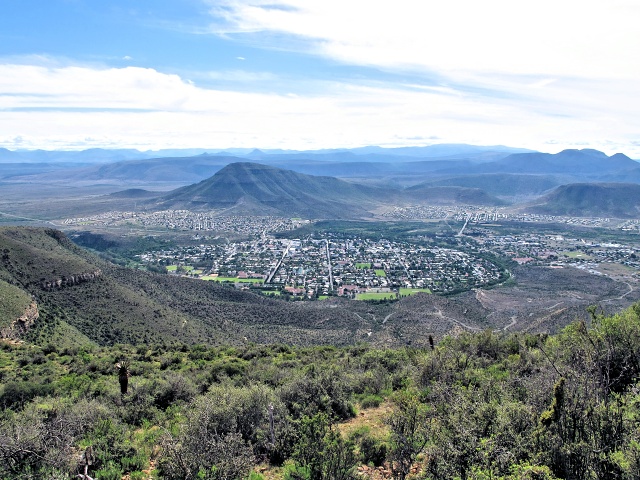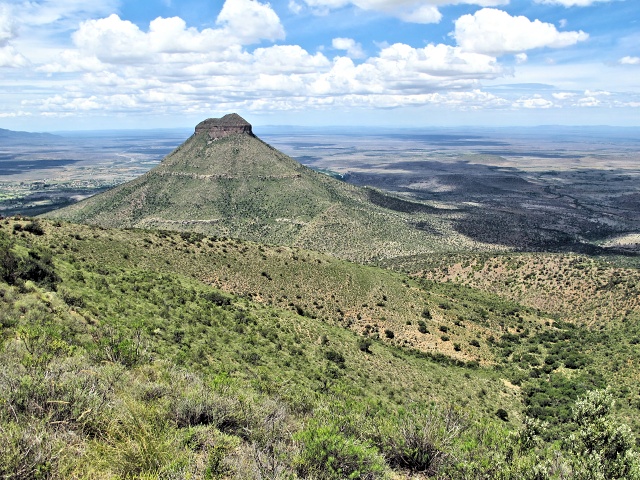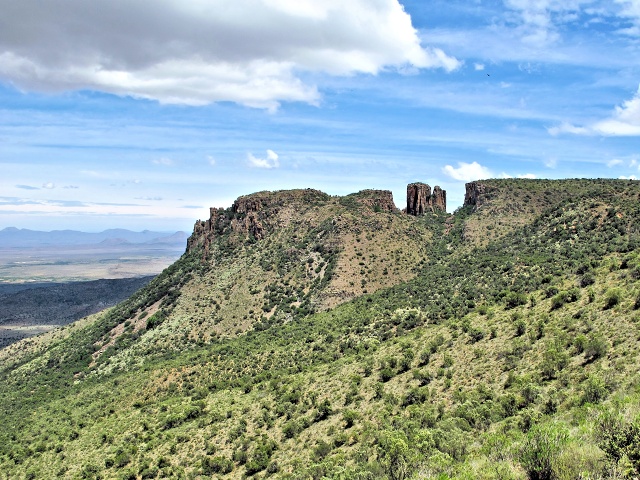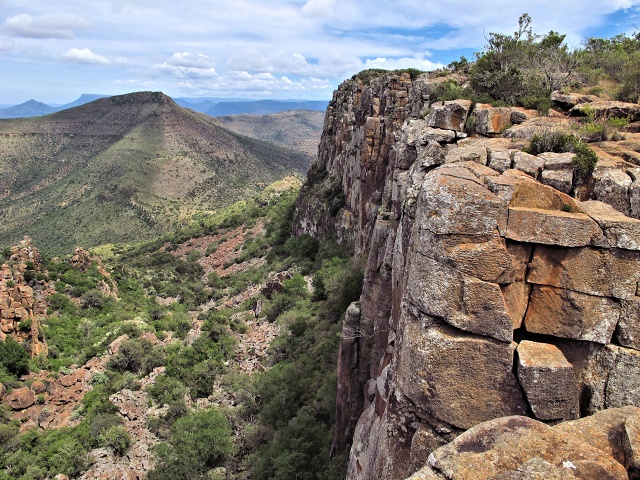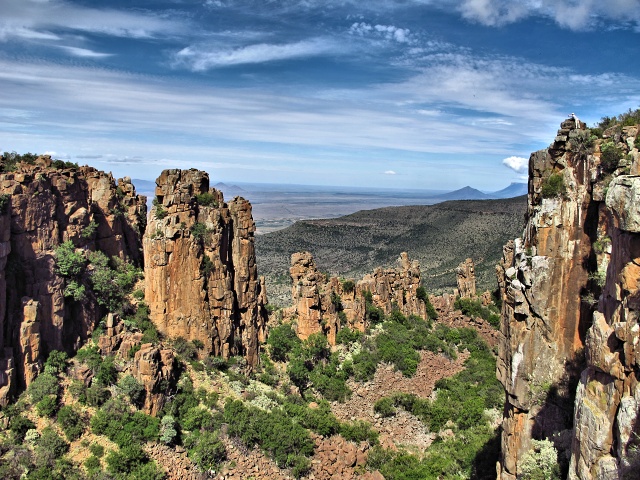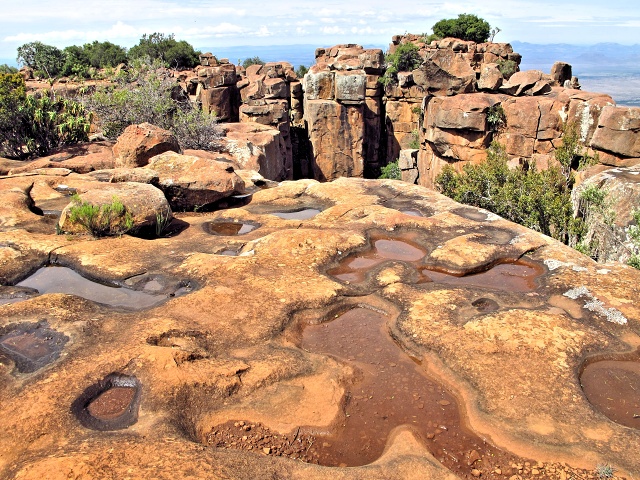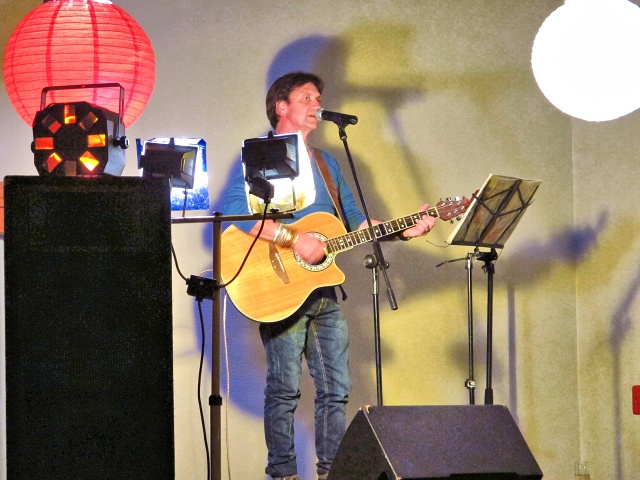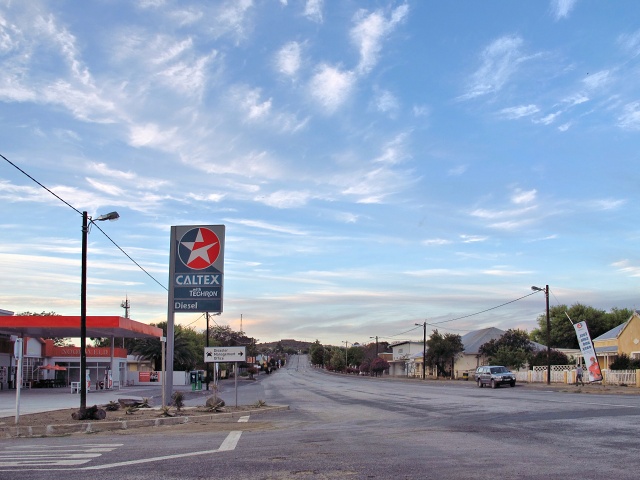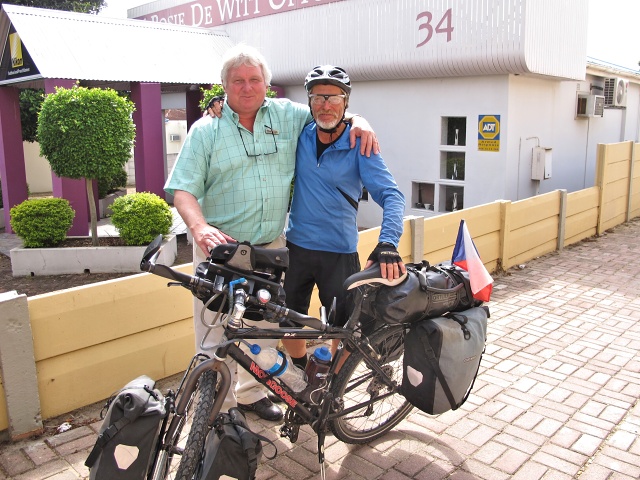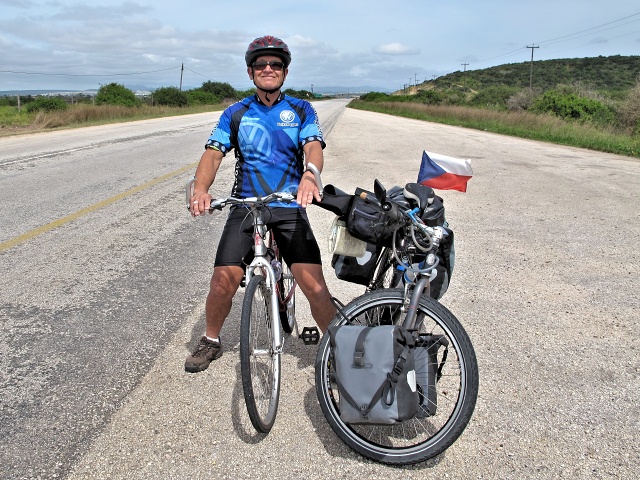| Cycling South Africa |  | |||||
 |
 |
 |
 |
 |
 |
 |
| Nothing compares to the simple pleasure of a bike ride. J.F.Kennedy | ||||||
| Three-month cycling trip, starting in late August 2012 in Windhoek, ending in Cape Town. Author's 9th expedition (New Zealand, Australia, USA, Canada, Alaska, Japan, Mexico, Bolivia, Chile, Argentina). |
|
To the Indian Ocean
She picked me up right next to the road
A van stopped at the rest place. A young woman got out and asked me where I was from. I told her, and she replied, “Fine, you understand English. And where are you headed to?” I said, "To Hopetown". She said, “So you can sleep at our place, we have a private room with bathroom for you. In the evening, our friends are coming for a braai and you should be there. The Caravan Park in Hopetown is bad, only homeless people live there." She gave me the address, and directions to find her home. I entered the data into the GPS, and in less than an hour I was in the garden of their guesthouse. Wilhelmina was a charming, friendly, very lively and practical woman. Her husband, Eric, was a likeable phlegmatic guy, originally from Seattle, USA. He and Wilhelmina had met in Greece, and he had then followed her to her native South Africa.
I was really amazed. In less than an hour they were expecting guests for the Saturday party, Wilhelmina had been shopping in Kimberley and with the purchases had brought home a dusty, sweaty bum. Eric was probably used to all sorts of things, so he did not even protest, but rather gave the impression that he was enjoying it. Wilhelmina brought me a laundry basket to put all my dirty clothes in and was simultaneously preparing food. Eric meanwhile was making the fire in the outdoor fireplace. I made an excuse that I was going into the town to take some photos. But there was nothing to see. My main goal was to buy something to drink for the party. Fortunately, the owner of grocery store also owned the adjacent liquor store. Although the liquor store was already closed, he willingly sold me a bottle of Black and White for less than 100 Rands. And so I was glad that I could at least minimally reciprocate the selflessly provided full board and lodging including drinks. The party was a success. Great ribs, a hearty soup which was boiled for about 3 hours on the outdoor fire, beer and wine. I definitely did not excel at darts, since I was playing it for the first time in my life. Finally, I found out that the target was about 2 cm higher than it should have been according to the rules (which were included in the darts' box) and so at least I had something to blame for my pitiful performance. What really surprised me was that everyone ate a lot and drank very little. In our country, everybody would have been tipsy after three hours, but not there. Perhaps the reason was that everybody had to drive home to often remote and poorly accessible farms. After the boring 130 km from Kimberley on the main road, I decided to continue my route inland on smaller roads. I was fed very well in the morning, Eric checked accommodation options in Petrusville, which was nearly 100 km distant, and Wilhelmina called there. She described the route to a farm, 4 km off the road, which quoted a surprisingly low price of 150 Rands for bed and breakfast. It was a Sunday, everything was dead, no one on the roads. That’s why I did not mind the lack of a verge. I could easily monitor the two cars per hour in my rearview mirrors. The Orange River supplies the whole area with water and therefore everything is green and luxuriant. Animals, such as Gemsbok, Springbok, jackal and even an ugly warthog showed up near the road.
Luxury on the Farm
I bumped along a 4-km dirt road, was welcomed by the dogs and then the farmer's wife. The accommodation was great. The guesthouse was separate from the farmhouse. There were stuffed trophies in the lounge of animals hunted on the farmlands, a kitchen, bathroom, and bedroom with four beds. Quiet, green trees around, the birds sang and the dogs rejoiced whenever I noticed them. I asked the farmer's wife if I could have dinner and how much it would cost. "You'll eat with us, and it is included in the price of 150 Rands." Just amazing. I checked and adjusted the bike, took a lazy two-hour walk and it was dinnertime.
A discussion with local farmers is always a celebration of rational and normal economic thinking (there is a reason for it being called 'horse sense'). It was the same with Mr. Van der Walt. There are no European subsidies distorting the agricultural economy, so farmers are forced to fend for themselves. While, in Europe, the most profitable agricultural product is paper – the completed application form for a subsidy – South African farmers must grow or breed only what thrives under the local conditions, and also what they have a chance of selling. On this farm, sheep were bred for wool and meat and goats sold in bulk to Indians in Durban. I enjoyed the simple Maths very much, how many acres are normally needed for one sheep and how many in a period of drought, and similar facts. It is natural that a farmer puts away part of the money earned for worse times, which inevitably come. Here a 'rainy day' means a series of several years of drought. After dinner, I looked at the picture gallery of ancestors, faded colored photos in decorative frames. 140 years ago these people founded and named the nearby town after themselves—Petrusville. A very pleasant evening, great food - homemade lamb chops and grilled chicken legs—and a mutually enjoyable and stimulating discussion.
Farmhouse Breakfast
It was worse out on the road. My body was giving priority to the more enjoyable activity and, instead of turning the pedals, was engaged in digesting the huge influx of calories. I just took it easy for the first 20 kilometers. After that, it improved slightly and after 70 km of cycling I finally knew that everything was processed and I was able to travel as usual. The first hunger pangs only showed up 110 km later.
If you want Pizza, go to Hanover
I had saved on the accommodation, so I did not cook and went out to a restaurant. Pleasantly refreshed by 0,7 liters of Castle Milk Stout (whose 6% alcohol content significantly increased my confidence in communication) I went to the local pizzeria. The pizza was great, thin dough, the right ingredients — the first pizza I had tasted in South Africa which was just like a genuine Italian pizza. I deservedly praised it to the owners. Meanwhile, we talked about my trip, I added a couple of travel stories with bears and crocodiles and the pub was mine. Saying goodbye was touching, I gave out my cards to all the diners, including the owners and staff. We shook hands and hugged in a friendly manner. An enjoyable and calorie-rich evening.
Thousands of Thank You E-mails
Judge for yourself:
From Hanover, I followed the N10 road to Middelburg, which is located in the foothills of mountains which are over 2,000 meters high. The road had been resurfaced, with a verge of about a meter, and there was very little traffic. The destination was about 100 km away, no marathon. Ideal conditions, if it were not for the wind. It grew stronger and stronger and reached a peak around noon, when I was not even able to reach a speed of more than 10 kph on the flat. The thick molasses simply would not allow it. Paradoxically, the situation improved during the ascent to the Winterhoek Pass (1,650 m). The hill shielded the wind a little, so I relaxed on the quite steep climb. In Middleburg, I anchored in the Caravan Park. I was the only tourist, otherwise there were local laborers who were building a large shed in which they were living. The Manager told me to use the women’s showers and toilets, that they were cleaner. His entire family also used the facilities. But I did not care, I ate ready-to-serve food from SPAR, pitched the tent, left the bags on the bike and by 8 p.m. I was already happily snoring. And I did not even need a beer or wine, this time green tea was sufficient.
A Day of Police
Road N9 was in great condition, a half-meter verge separated me from the traffic, so I could devote myself to pedaling uphill. There was no wind and it even caught me by surprise when suddenly I had reached the top of the Lootsberg Pass (1,760 m). During the ascent, I saw a local black eagle with a snake at least half a meter long hanging from its beak. I spotted the eagle with the snake slowly gliding down in circles into the valley, where it made two low flybys and then landed softly on the grass and began to snack. The remaining 60 km were actually just downhill, with the exception of the Naudeberg Pass, where the climb was less than 5 km long. Along the way, I found a driving license on the road, together with a Gold credit card and one more ordinary payment card. In Graaff-Reinet, I went to the Police station and handed them over there. I had a third Police encounter – a lady motorist arrived at the crossroads and a Police car coming from the opposite direction began to honk at her. The frightened woman stopped her car, guiltily rolled down the window and waited for a Police scolding, although she certainly did not know what her offence had been. A Policeman came up to her car, closed its open hood and told her that she could continue. Well, this was really excellent service!
Graaff-Reinet
A Cultural Outing
Camdeboo National Park
The first attraction is the Nqweba Dam with its picturesque spillway. The Dam is also in the Park. Many birds live in the vicinity and can be observed at close range from the shores of the Dam. But this is also forbidden to cyclists. Another attraction is the memorial to Gideon Scheepers, a young Boer officer who was sentenced to death by the British and executed at the age of 24 years. The monument stands 100 meters from the site of his execution which was originally on the river bank and is now under the waters of the Nqweba Dam. However, the British removed his body from the grave a day after the execution and burned it at an unknown site. Yet they did not prevent him from becoming a legend and a symbol of Boer resistance. A narrow, sometimes very steep, paved road leads to the Valley of Desolation. The Ranger, to whom I paid the entrance fee, tried to talk me out of the trip and depicted the terrain as being very bad. Not many cyclists probably came there. Yes, it was quite steep, but without the bags and with some effort I made it in the lowest gear. Unfortunately, I sweated through my freshly laundered clothes, which I originally had not intended. In the worst parts, I cycled in a zig-zag style to moderate the steepness of the climb slightly. However, I did not have to push the bike a single millimeter.
A leopard tortoise, about half a meter in diameter, strolled on to the road. First it was afraid of me, but then it gained courage and even walked up to me. I rather sat on the bike and pedaled away. Then I had to stamp very loudly a few times on the road to force a yellow snake, about 1.5 meters long, to slither out of the road.
The first stop at the top was the Toposcope. From there, Graaff-Reinet was spread out at my feet. I could locate the guesthouse in which I was staying, as well as all the sights of the city. The town is small, but surrounded by several large townships of exclusively indigenous inhabitants.
Then, just a few hundred meters further on, I reached the lookout spot over the Valley of Desolation. The rocks are very scenic and sheer, dropping straight down hundreds of meters. Falling down there would probably have fatal consequences. However, the view from the edge of the cliff was most impressive. So I carefully balanced at a safe distance from the edge, while most people remained standing on the lookout spot bounded by a wall. The 45-minute Lizard Trail is at the top, which I followed, probably as the only visitor to do so that morning.
In High Society
In the beginning, the singer was not very good, he sang to recorded music and in some of the songs I had the impression that even his singing was a playback. After I had digested a delicious dinner and tasted the cheap but not too bad red wine, it took a turn for the better. The singer abandoned his art and began to devote himself to popular entertainment. He sang some Golden Oldies from the 60s. A few people got up to dance, despite them not being such great dancers, or their coordination already having being impaired. I did not last until the end, yet it was a pleasantly spent evening.
I could go either through Somerset East or Jansenville to reach Port Elizabeth. Both routes follow local roads, the latter seemed straighter to me. The weather changed. The whole morning was overcast, the clouds rolled low above the ground, at times it drizzled. Then the South (head)wind blew it away and made the day. I stayed over in a guesthouse in Jansenville. Reasonable price – 150 Rands – and I could use a large bedroom, lounge, bathroom and kitchen. I asked about the key, but the owner told me that nothing was locked there and that the entrance was monitored by CCTV, so I could relax. There was no place of interest in the town, only several highly intoxicated drunks who obviously wanted the intoxication to last all the way from Saturday to Sunday when alcohol would not be on sale. Well, the regulation of anything is a bitch and often tends to have unintended consequences.
On the next day, I had to cycle 145 km to Uitenhage, to reach the nearest accommodation. At that time I was already so self-confident that I had stopped carrying a water reserve in case of having to sleep by the road. I simply had to make the 145 km and that was that. There was really no accommodation along the way, but I encountered two pubs in which I ate. It was hard to leave the second one. I had a snack and coffee. I first chatted with the Germans, then with the Swiss and then the locals called for attention. A car arrived, people took photos of the bike and started questioning me. Of course I enjoyed the interest, but I had already covered over 100 km and 40 km still lay ahead of me, with new hills on the horizon. An hour later, I forced myself to depart and complete the rest of the journey.
Uitenhage
I bought breakfast in the adjoining Pick n Pay supermarket. The expensive accommodation (compared to where I normally stay, otherwise the price was quite normal) included a hearty breakfast. I had smoked salmon, cucumber, fresh buns and finally yogurt. I parted warmly from the Manager. He was a great guy, but I was already curious to see the Indian Ocean. Along the way, I met local cyclist, Gregory Yolanda, who was training daily for the December race in Cape Town, to which he also invited me. Well, we men over 60 must train every day, otherwise we'll never get fit. Gregory was very religious. He explained to me that it was no accident that I had survived so far and that I was accompanied by a cohort of angels. He warned me to watch out for thieves in the cities. And he added that he would pray for a happy ending to my trip. A gale-force wind was blowing, but this is reputedly normal in the area. Therefore he advised me to turn towards Swartkops and then return to PE after I had reached the ocean. The first part was great, the wind blew from 4 o'clock, I only needed to adjust the position of my body and did not even have to pedal very hard. The 9 km along the coast to PE was the worst. The wind blew from 1 o'clock and the gusts shook me so hard that I feared I would be blown under a passing car. That is why, wherever possible, I preferred cycling on the bumpy verge. There was the typical Monday city bustle, but I managed to navigate and soon found accommodation in the second of the selected Backpackers. And because, in the rush, I had even caught a glimpse of the Indian Ocean, I could finish this chapter with an easy mind.
  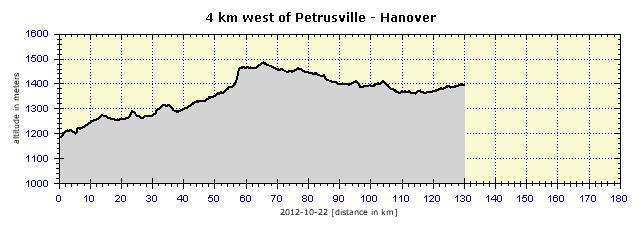 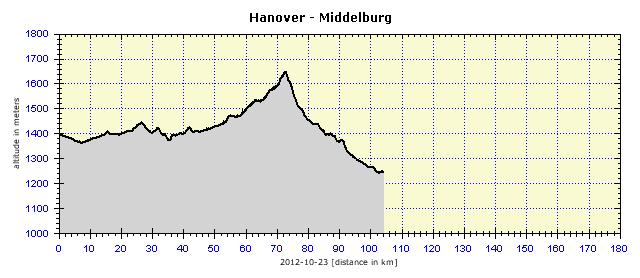 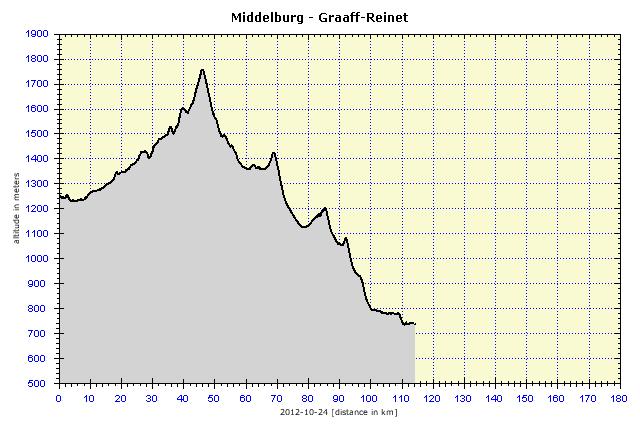  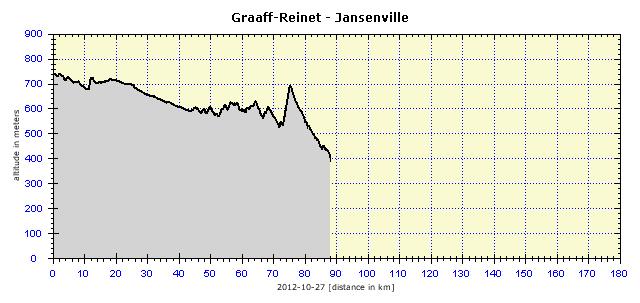 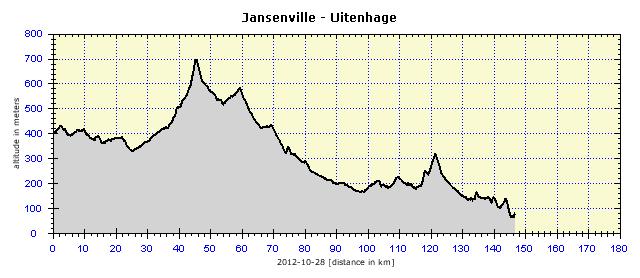  |
